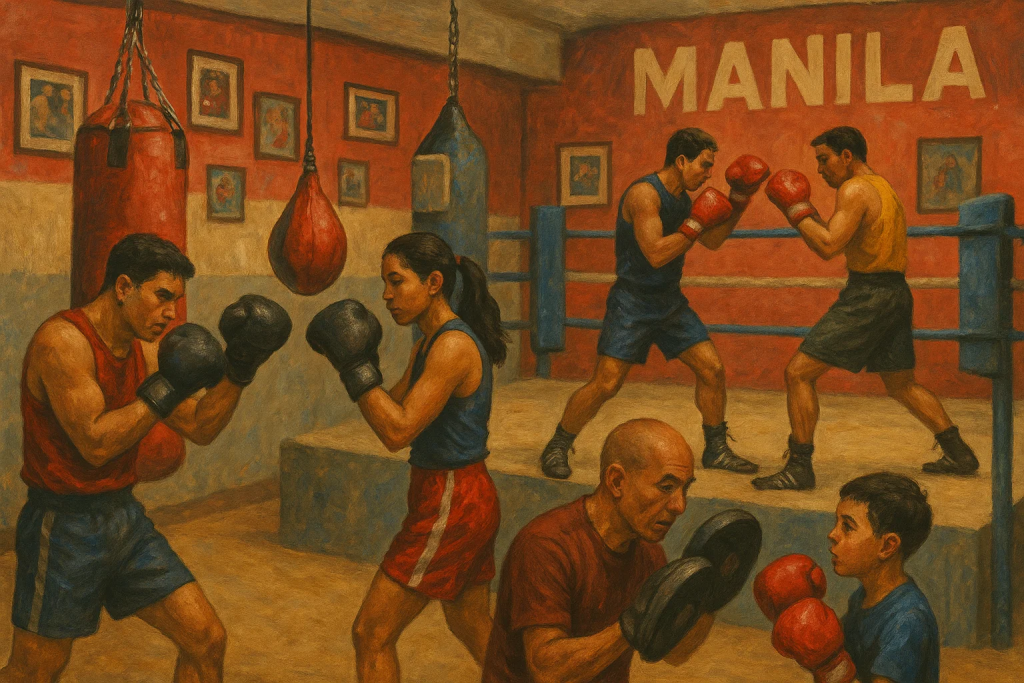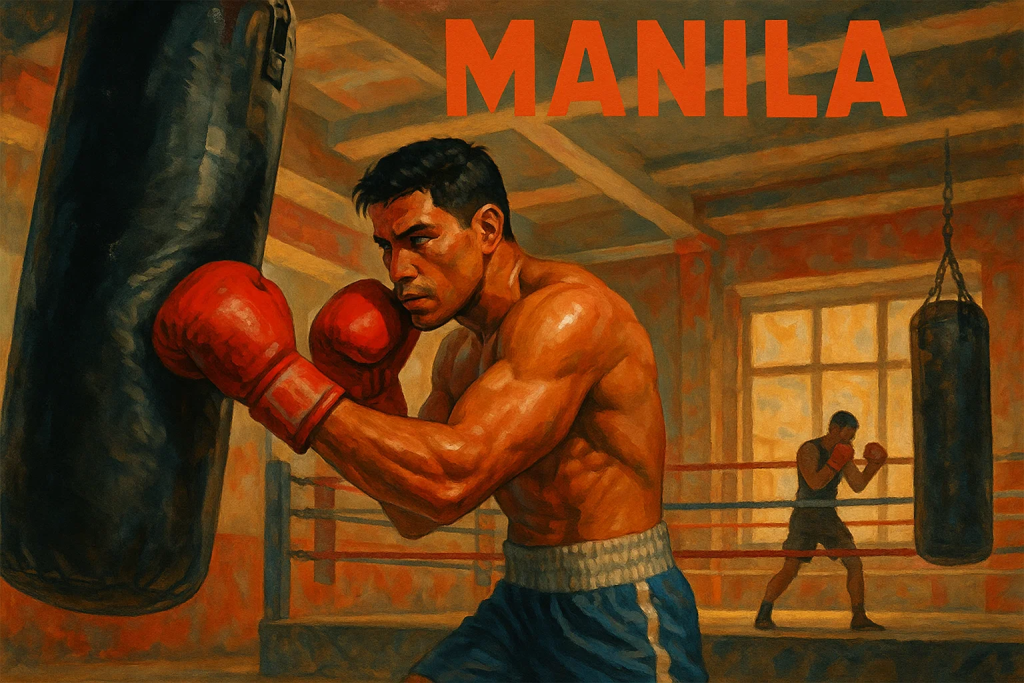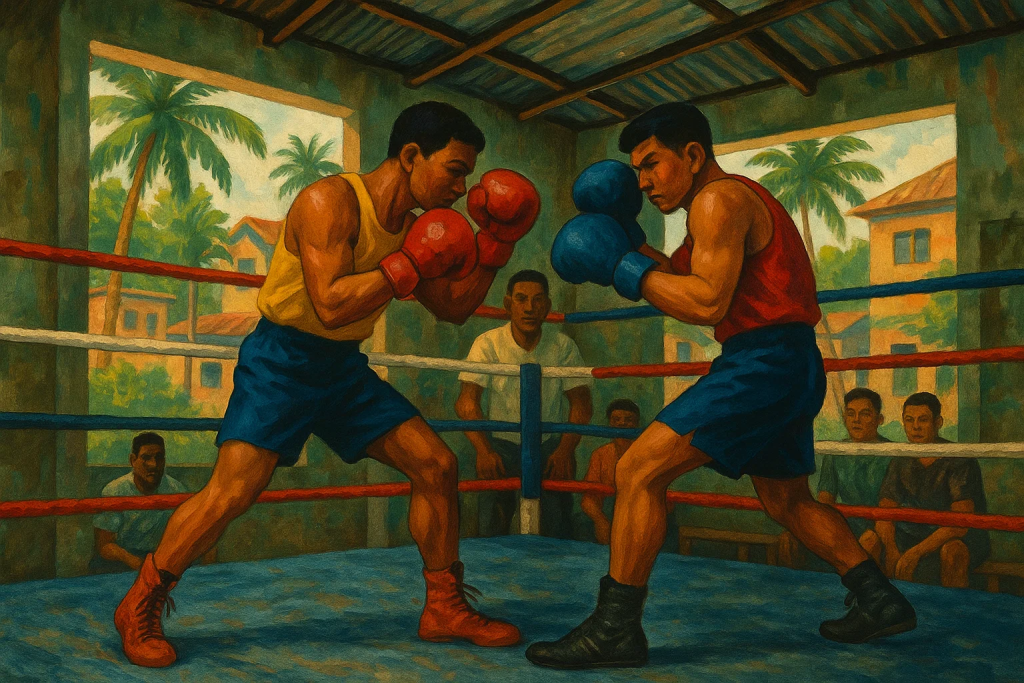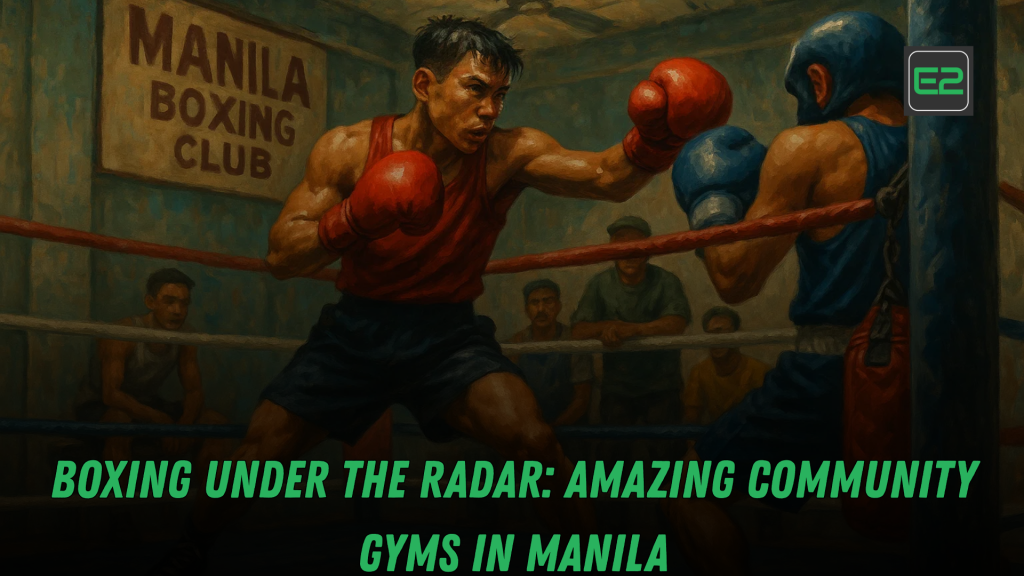Table of Contents
If you’ve ever dreamed of slipping on gloves on boxing, hearing the slap of mitts, and learning the sweet science without the intimidation of boutique studios, Manila’s community boxing gyms are calling your name. Tucked inside barangays and beside busy streets, these under-the-radar spots are where everyday people—students, nurses on shifting schedules, call center pros coming off a graveyard, even parents bringing kids after school—come to train hard, laugh often, and get genuinely better.
This long-form guide is your friendly map to that world: how to find a gym near you, what to expect on day one, how much to budget, and how to progress safely from beginner footwork to crisp one-twos and confident defense. It’s crafted for search visibility (so you can actually find it when you need it) and for real people (so you can use it the same day you read it).

Why community boxing gyms in Manila hit different
1) Proximity and consistency. When the gym is near home, school, or your commute line, you go more often. That consistency is the true fat-burner and skill-builder. Many neighborhood gyms sit a tricycle ride away or a short walk from main jeepney routes. In Manila’s time-and-traffic economy, this is everything.
2) Coaching over aesthetics. Community gyms are coach-first. Expect hands-on pad work, individualized corrections, and fundamental drills that actually translate to better punching mechanics. You’ll rarely see gimmicks; you will see real progress.
3) Inclusive culture. These places are for beginners as much as they are for amateur hopefuls. Coaches know how to scale volume, modify combinations, and teach at the pace your lungs and legs can handle. Don’t be surprised to share a round with a high schooler on their first day and a 40-something rekindling an old love for the ring.
4) Budget-friendly training. “Affordable boxing gym in Manila” isn’t clickbait; it’s a reality of the community scene. Many gyms keep rates reasonable for drop-ins and offer discounted bundles for frequent training. Kids and students often get special pricing.
5) Real results. With a fundamentals-first approach, you’ll feel improvements quickly: steadier stance, snappier jab, cleaner breathing, better posture, and that secret superpower called confidence.
What “under the radar” really means in boxing
When people say “under the radar,” they usually mean not a glossy chain—the gym might be upstairs from a sari-sari, behind a basketball court, or tucked into an alley you would’ve missed without asking for directions. The walls might be painted by community volunteers, the ring might be compact, and the speed bags might have seen better years. But what you’ll often find is a serious training culture: a bell that actually rings, mitts that actually pop, and coaches who remember your name and how your rear foot tends to drift when you throw the cross. If “authentic” means anything in fitness, this is where you’ll find it.
How to choose the right community boxing gym (a practical checklist)
Use this checklist to evaluate any gym—first on social pages, then in person:
Coaching & attention
- Is there structured time for pad work with a coach?
- Do trainers offer technical corrections (stance, guard, chin tuck, hip rotation)?
- Are beginners acknowledged at the start of class?
Program structure
- Are there fundamentals or Boxing 101 sessions for new members?
- Is sparring optional and permission-based—never pushed on beginners?
- Is there a clear path from day one to light drills, then to optional controlled sparring?
Safety & cleanliness
- Are wraps required? Is there guidance on proper wrapping?
- Are loaner gloves available and clean, or is gear purchase encouraged after a few sessions?
- Is there a basic first-aid kit and a coach watching ring activity?
Pricing clarity
- Are drop-in rates, bundles, and add-ons (personal pads, one-on-one training) clearly communicated?
- Do they offer student or kid pricing?
- Are there hidden fees (e.g., mandatory membership) you should plan for?
Schedule & location
- Do class times line up with your routine (pre-work, lunchtime, post-work, weekends)?
- Is the gym a realistic commute, even on rainy days and heavy traffic?
Community vibe
- Does the space feel welcoming for women, teens, and older beginners?
- Do members look supportive of first-timers?
- Is there an obvious culture of respect—no ego, no showboating at the expense of newbies?
If a gym checks most boxes, show up for a trial. Chemistry with the coach and crew matters more than any polished equipment list.
What a Boxing beginner session usually looks like
While every gym has its rhythm, a typical “boxing for beginners Manila” class flows like this:
- Warm-up (8–12 min)
Jump rope, dynamic mobility, light shadowboxing. The goal is to raise temperature, wake up the feet, and cue your stance. - Fundamental technique (15–25 min)
Stance and guard (how wide, how to tuck the chin), basic punches (jab, cross), footwork (step in/out, pivot), and simple defense (catch, slip). - Rounds (20–30 min)
Alternating between heavy bag, shadowboxing, and—if you’re ready—pad rounds with a coach. Beginners may do more shadowboxing to groove mechanics before adding power. - Conditioning finisher (5–10 min)
Short circuits: bodyweight push/pull, core, medicine ball throws, or cycling intervals. Expect a sweat, not a marathon. - Cooldown (3–5 min)
Breathing, light stretching, and a quick recap of cues to remember for next time.
The “first week” game plan (so you don’t overdo it)
Your goal for Week 1 is consistency, not heroics. Two or three sessions are perfect. Tell your coach you’re new; they’ll scale your rounds and keep a close eye on your guard, feet, and breathing. Plan your days:
- Day 1: Fundamentals + light rounds. Focus on stance—where your feet go, where your weight lives.
- Day 3: Repeat fundamentals. Add a touch of speed to the jab. Keep breathing smooth.
- Day 5: Technique revisit. Introduce simple combos (1–2, 1–2–1) and a basic defensive reaction (catch or slip).
Sleep, hydrate, and keep an easy walk on off-days. Soreness is normal; sharp pain is not. If something feels off, flag it to your coach.
A progressive 6-week beginner program (3 days/week)
Goal: move from zero to technically competent—able to handle 2–3 minute rounds with good form and controlled breathing, and to understand optional sparring etiquette even if you don’t spar.
Weeks 1–2: Foundations
- Warm-up: rope + joint mobility (hips, ankles, thoracic spine)
- Technique: stance/guard, jab, cross, basic footwork (step in/out, side step)
- Rounds: 4–6 rounds x 2 minutes (shadow + bag, light power)
- Defense intro: catch/parry, basic slip
- Finisher: core stability (planks, dead bug), easy cooldown
Weeks 3–4: Movement & rhythm
- Add pivots and exits after combos
- Build combos: 1–2–1, 1–2–3, 2–3–2
- Rounds: 5–6 rounds x 2–3 minutes (bag + supervised pads)
- Defense: slip-2, roll-3-2 (slow, technical)
- Finisher: moderate circuits (pushups, band pulls, bike intervals)
Week 5: Timing & pressure management
- Introduce reactive pad calls (slip, counter, move your feet)
- Rounds: 6–8 rounds x 2–3 minutes (technique over brute force)
- Defense: block-3, roll-2, angle out after offense
- Finisher: short conditioning burst; cooldown breathing to bring HR down
Week 6: Consolidation
- Combine footwork, defense, and clean punching
- Optional technical sparring (only if coach approves): 2–4 very light rounds with headgear and clear rules
- Goal: exit the program with smooth mechanics and the confidence to self-regulate pace
Gear checklist for Manila Boxing beginners
- Hand wraps (180”) — cotton or elastic; learn to wrap snug without cutting off circulation.
- Gloves (12–16 oz) — start with 14–16 oz for general training; 12 oz may fit smaller hands or pad work.
- Mouthguard — essential if you ever progress to partner drills or technical sparring.
- Training shoes — anything with a flat-ish sole and lateral support works; some gyms use mats (ask about shoe rules).
- Towel & water bottle — Manila humidity is no joke; hydrate before, during, and after.
- Optional: quick-dry shirt, light shorts/leggings, deodorizing spray for gloves, a mesh bag to air out wraps.
Tip: wraps are the cheapest and most impactful hygiene investment. Own at least two pairs so one can dry while the other’s in use.
How much do community boxing gyms in Manila cost?
Prices vary by neighborhood, facility, and service level, but community spots are known for budget-friendly rates. You’ll typically encounter:
- Drop-in classes (group hours with coach supervision)
- Bundles (e.g., 8 or 12 sessions/month) that reduce per-class cost
- Kids & student rates in family-oriented gyms
- One-on-one pads or personal coaching at an added cost for deeper focus
Always ask whether pad work with a coach is included in the rate or considered a personal training add-on. This detail changes the experience dramatically for beginners.
Safety and etiquette (the unglamorous keys to progress)
Tell the coach you’re new. They’ll place you where they can see you, scale rounds, and offer reminders that prevent bad habits.
Wrap correctly. Proper wrist and knuckle support prevents sprains and sore hands. Have a coach check your first few wraps.
Punch with form, not pride. Power comes later. First, learn to align knuckles, wrist, elbow, and shoulder while rotating hips and feet.
Glove hygiene matters. Wear clean wraps, wipe gear after sessions, and let gloves air-dry fully. Your future self will thank you.
Ring rules. Never enter the ring without permission. If you’re allowed in for drills, step between the ropes safely, remove jewelry, and follow instructions exactly.
Sparring is consent-only. It’s optional, controlled, and coach-supervised. If you don’t want to spar, say so. If you do, your job is to protect your partner as much as yourself—go light, listen to the coach, and keep it technical.

Neighborhood-by-neighborhood: how to scout hidden gems
Tondo / Gagalangin / Balut
Ask neighbors, barangay staff, or basketball regulars—someone will point you to a coach with mitts nearby. Expect compact facilities, high energy, and serious attention to basics.
Sampaloc / U-Belt
Student-friendly schedules and walkable gyms are common. If you’re new, look for beginner blocks early evening when student traffic is high and coaches expect first-timers.
Quiapo / Sta. Cruz / Intramuros
You’ll find old-school flavors—spaces where the culture is as rich as the mitt work. Great if you want grit, music, and a pace that pushes conditioning.
Makati / Mandaluyong / Pasig
Residential pockets hide coach-led studios attached to bigger fitness spaces. Expect clearer schedules, well-lit rooms, and often, access to showers.
Taguig / BGC
Community-forward gyms live beside slightly more polished facilities. If you work in the area, late-night classes help beat traffic and maintain consistency.
Quezon City (QC)
The Timog and Maginhawa corridors are full of multi-discipline spaces (boxing + Muay Thai + BJJ). Ideal if you like variety while keeping boxing as your base.
Pasay / Parañaque
Look around transport hubs and barangay sports centers. Local coaches often run youth hours in the afternoon and adult blocks at night.
Caloocan / Valenzuela
Warehouse-style corners and upstairs studios dot these zones. Prices tend to be friendly; ask about beginner on-boarding and gear guidance.
Wherever you are, the rule is the same: trial first, ask questions, and observe how coaches interact with new people.
The beginner’s performance pyramid of boxing (what to focus on, in order)
- Breathing and base — quiet nose-in, mouth-out breathing and a stable, balanced stance.
- Guard and eyes — hands return to home, chin tucked, eyes sharp and relaxed.
- Footwork before combinations — your feet place you in range; punches finish the job.
- Straight shots before hooks — the jab and cross build your line; hooks and uppercuts come after mechanics settle.
- Defense woven into offense — add slips, catches, and exits after you punch.
- Volume and conditioning — once technique is consistent, extend round length and shrink rest.
Progress isn’t linear—some days feel clumsy, then suddenly everything clicks. Keep showing up.
Programming for busy Manila schedules
Shift workers: choose gyms with late-night or early-morning classes. Keep your first week at two sessions to protect sleep and recovery.
Parents: look for youth hours that align with your adult class. While kids train, you can, too.
Students: cluster training with existing campus commutes. Rope in a classmate so accountability is built-in.
Office workers: pick a gym near the office for pre-traffic training, or near home to avoid the commute entirely. Pack wraps and clothes in your bag so you can’t talk yourself out of going.
Conditioning that supports better boxing (no treadmill required)
Rope intervals (8–12 min): alternate 30 seconds smooth, 30 seconds brisk footwork.
Shadowboxing ladders: 2-minute round light, 2-minute technical, 2-minute brisk; rest a minute; repeat.
Core tri-set: plank (45s), dead bug (6/side slow), side plank (30s/side).
Carry work: farmer’s carries with kettlebells or heavy bags to build grip and trunk stability.
Upper-back work: band pull-aparts or cable face pulls to counter desk posture and support a consistent guard.
You don’t need marathon circuits that crush you. You need repeatable volume that gets you back to the gym two days later.
Nutrition and recovery for Manila’s climate
Hydration: Start your day with water and sip consistently. Manila heat plus indoor rounds equals heavy sweat.
Salt and potassium: Balanced meals with vegetables, fruits (bananas, citrus), and a sensible pinch of salt help keep cramping away.
Carb timing: Light carbs pre-class (banana, toast, or rice with egg) give quick energy; a fuller meal after helps recovery.
Sleep: Treat sleep like training. Dim screens, cool your room, and give your nervous system a nightly off-switch.
For women and teen beginners
Community gyms in Manila increasingly welcome women and teen boxers with structured fundamentals and clear boundaries. If you’re nervous, ask for a women-friendly beginner slot or visit during quieter hours for more coach attention. Your safety and comfort are non-negotiable: spar only if you want to, and only under strict supervision with protective gear. Remember, you do not need to hit hard to get fit or to learn real technique.
For parents: why youth boxing works
Discipline & focus. Combinations, footwork, and pad timing demand attention—great for kids who need structured outlets.
Confidence & social skills. The bell system, partner drills, and coach feedback build poise and respect.
Athletic foundation. Boxing develops coordination, balance, and cardio without requiring long-distance running.
Life skills. Learning to breathe through discomfort, follow rules, and put effort into practice transfers to school and home life.
Ask about youth-class rules, required gear, and the path from basics to optional recreational bouts. Keep it fun first; intensity comes with maturity and coach guidance.
How to stretch your training budget
- Start with a trial to test fit before buying gear or long bundles.
- Go for bundles when you’re sure you’ll attend 2–3x per week—per-class cost drops fast.
- Bring your own wraps on day one; buy gloves once you’re sure you’ll stick around.
- Train off-peak if possible; smaller classes often mean more mitt time.
- Share rides with classmates in the same barangay or schedule back-to-back with a friend.

The mindset that keeps you coming back
You’re not chasing a highlight reel; you’re building a practice. The bell rings, you breathe, you move your feet, you place the jab. Some days the bag feels heavy and your shoulders whine; other days you’re a metronome of clean shots. Either way, you improved because you showed up.
Three reminders:
- Technique beats force. Clean mechanics are safer, faster, and ultimately more powerful.
- Small wins add up. One extra round today is 100 extra rounds across a year.
- Community is a superpower. Say hi, learn names, celebrate others’ firsts. You’ll get more feedback, more fun, and better results.
Philippine MMA Amazing Coaches Share Bedrock Training Principles
Strong call to action
Choose one gym within 20 minutes of home, school, or work. Book a trial this week. Tell the coach you’re a beginner and bring wraps, water, and curiosity. Send this article to a friend and invite them along—accountability doubles your chance of showing up. When you land your first balanced one-two and hear the mitts sing, you’ll understand why Manila’s neighborhood rings stay busy long after sunset.
Frequently Asked Questions (FAQs)
1) How much do community boxing classes in Manila cost?
Prices vary by neighborhood and facility, but community gyms are known for being budget-friendly. You’ll typically see options for single-session drop-ins, discounted bundles (such as 8 or 12 sessions per month), and special rates for students or kids. Ask whether personal pad sessions or one-on-one coaching are included or considered an add-on.
2) I’m completely new and not very fit—can I still join?
Absolutely. Community boxing gyms in Manila are beginner-ready. Tell the coach you’re new so they can scale rounds and focus on fundamentals—stance, guard, jab, breathing, and footwork. You don’t need prior experience or a big gas tank. Improvement comes from consistent, well-coached sessions.
3) Will I have to spar?
No. Sparring is optional, coach-approved, and supervised. Many members never spar and still build excellent technique, conditioning, and confidence. If you do want to try it later, you’ll progress through technical drills first and use protective gear. Consent and safety come first.
4) What gear do I need to start?
Bring hand wraps, a water bottle, and comfortable training clothes. Gyms usually have loaner gloves, though most people buy their own after a few sessions for hygiene and fit. If you ever move toward partner drills or sparring, add a mouthguard and, later, headgear as directed by your coach.
5) How quickly will I see results?
Most beginners feel improvements in coordination and stamina within two to three weeks of consistent training (two to three sessions per week). Your jab gets snappier, your feet feel lighter, and your breathing steadier. Physical changes vary by person, but the biggest early wins are confidence and skill—both of which compound as you keep showing up.
